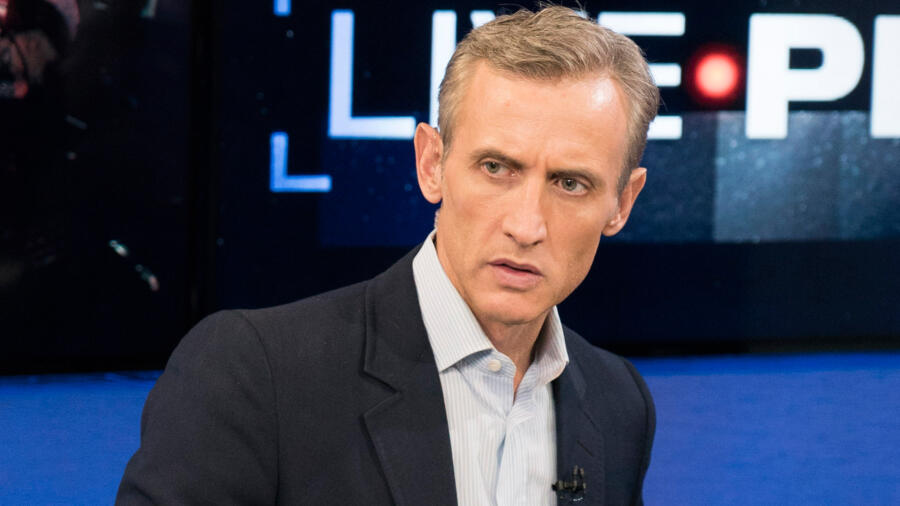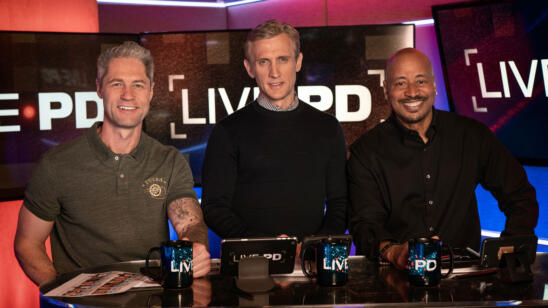Live PD is unlike any show that’s come before: an unscripted, live window into the work lives of numerous police officers from several municipal police departments around the country. For fans, the scope of the show can be electrifying. But for the producers, keeping up with all that simultaneous action is a high-wire act. A&E True Crime spoke with the show’s host Dan Abrams to discuss how body cameras and TV cameras help law enforcement with transparency and when they won’t go live with a story.
On Live PD we see a lot of people in the studio watching many police departments simultaneously. How are decisions made about what airs? Is there a formula? A single main producer? A military-like chain of command?
There’s definitely no formula—it completely depends on what’s happening. It starts with the people in the field, who are saying ‘Hey guys, we just got a call about this or that’ and that begins to shape the views of the producers. There are also loggers (story producers who are monitoring what’s going on in each city through video feeds) who are in the control room, so they’ll then be involved (by flagging action in those cities). But ultimately it’ll be the decision of the [Executive Producer] Dan Cesareo and the other producers.
How do you manage the fast-paced, off-the-cuff nature of the show?
For me, it is a really hard show to host because there’s so many things going on in so many different departments because there’s so much movement. It’s really tough, but really exciting. I have done years and years of live news programming and I think that the beginning of this show was harder than any other anchor or hosting gig I’ve had, because in the news arena you never have six live events happening at once. You have two, maybe three. Live PD is in 12 police cars.
From the production side, the decision to run the show live means you have to relinquish a lot of control over the kinds of storytelling you do. Given the constraints, why do you think it’s important that Live PD be a live show, rather than taped?
The essence of Live PD is the live part of it. It’s the unfiltered nature of what’s happening. It’s the grittiness. And that means sometimes it’s slow… and sometimes it’s really high-octane. There are police shows that are taped, but all they do—it’s like they have a greatest hits. But the uncertainty that police officers face is also fascinating to watch.
For safety reasons, do you ever decide not to go live even when something seems like it’d make for great television?
There are absolutely times when we don’t go live with a story. If there are children involved sometimes we won’t. If we think that there’s mental illness. We won’t if there’s an undercover officer who we think could get exposed. That’s why we have a delay—so we can assess the stuff and make a decision.
Why do you think so many Americans are fascinated by the show?
It’s the uncertainty. People are interested in police work. [In my experience] covering trials, the reason people are interested in trials is there’s a soap-opera element of what’s going to happen next. With police officers it’s not quite like that, but there is definitely a level of uncertainty, a level of danger that always exists for police officers in the street… and the viewers share in that experience.
What’s been your favorite moment on the show so far?
In terms of most memorable would be the moment with Chris Mastrianni [Deputy Sheriff of the Richland County South Caroline Sheriff’s Department] and the fight with the guy who had a baby in his hand. That was an unforgettable moment.
What’s your opinion on the use of body cameras by some police departments?
Police officers now have body cameras, which is not dissimilar from what Live PD is doing. I think body cameras, our cameras—all cameras—help ensure a level of professionalism that existed in the vast majority of cases anyway and it also allows for the public—or in the case of body cameras, an investigator—to see what the suspect was doing as well. More transparency is better. There’s a reason so many police departments are embracing [them].
After watching so many police officers live at work for hundreds of hours so far on Live PD, do you have a different view of what they do than you did before hosting the show?
I’ve been on ride-alongs before, but I had never spent six hours every weekend with police officers, so I have definitely gotten a better sense of what they deal with every day. They’re dealing with everything from surly people who are being pulled over to dangerous situations to people who are urinating in the back of a police car. And guess who has to clean that up? The officer.
It is important for people to see what officers deal with every day. In the news, coverage of course tends to gravitate to the controversies: the times when someone is alleging wrongdoing on the part of the police.
I have a better sense now of what officers are doing when there are no guns drawn and no weapon fired and no news coverage, which for police officers is almost all their time.
Is there anything you learned about police protocol that you didn’t know about before you started working on the show?
I didn’t realize that they touch the back of a car [they pull over] so often before they approach it to leave their prints. [Editor’s note: This is primarily a safety precaution to ensure that there is proof the officer approached the vehicle.]
Read more: Dan Abrams on the ‘Most Disappointing’ Murder Trial Verdict


